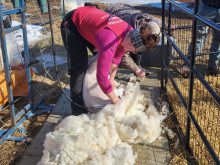RED DEER Ñ A new method of killing old laying hens is faster and more effective, according to an Alberta animal welfare specialist.
The system, developed in Alberta, uses carbon dioxide in an enclosed chamber to render birds unconscious in about 10 seconds and kills them in 30-60 seconds, said John Church, provincial animal welfare specialist with Alberta Agriculture.
The system can be used on the farm for old laying hens but could be expanded if flocks had to be removed quickly because of a disease outbreak such as avian influenza, he told Alberta Farm Animal Care’s annual meeting April 1.
Read Also

Charges laid after cattle theft
Saskatchewan RCMP lay two charges against a man after six cattle went missing.
Past systems could take up to two minutes before the birds lost consciousness. Other systems were too small and were difficult to empty of dead birds.
“We’re hoping to use this as part of our strategy in the event of another avian flu outbreak,” Church said.
When British Columbia had to destroy flocks last year because of avian flu, barns were closed and the birds died of heat stress. It took too long for them to die and was not considered the most humane method of disposal.
Until five years ago, older birds were shipped for processing to a federal plant in northern Alberta after a 52-week production cycle of laying eggs. Because of declining markets, the plant no longer accepts the hens so other means to dispose of them on the farm were needed.
Not everyone believes the new method of killing chickens is better. In a News release
news a group called United Poultry Concerns, which promotes compassionate treatment of domestic fowl, said it’s unlikely the killing is as quick and painless as Church claims.
Pointing to a British study describing the effects of CO2 on the body, the group said the gas induces breathlessness which causes a slow, painful suffocation.
“The system may be cost effective, but it cannot be called humane,” said Karen Davis, president of United Poultry Concerns.
Church also said caring for laying hens is going high tech, using the kind of technology used with high performance racehorses.
Infrared thermography is a non-invasive process used to detect lameness or other inflammation by picking up hot spots on an animal’s body.
“This is state of the art when it comes to lameness detection,” Church said.
“We know there are areas of probable soreness associated with heat or inflammation.”
Thermography could also be used in dairy cattle, where lameness is a common problem.

















